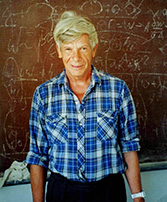Speaker
Description
Magnetic skyrmions (MS) are topologically protected configurations of local magnetization, observed, e.g., in non-centrosymmetric magnets with Dzyaloshinskii-Moriya interaction. In thin films MS arrange to 2D skyrmion crystals (SkX) [1]. The twisted character of skyrmionic configurations complicates an analysis of elementary excitations in such systems. We develop a novel approach that allows the study of magnon dynamics in presence of the topologically nontrivial background [2]. This approach is based on a combination of semiclassical methods and stereographic projection representation of the local magnetization.
The equilibrium configuration of SkX is defined in terms of the function of complex variable. We show numerically that the stereographic function of SkX corresponds rather precisely to a simple sum of stereographic functions for solitary skyrmions. Allowing infinitesimal variation of the stereographic function, we find normal modes of fluctuations in harmonic approximation. We calculate excitation spectrum of SkX and show that the appearing bands can be classified in terms of deformation types of individual skyrmions: dilatation, elliptical deformations etc. The topological properties of magnon band structure, i.e. Berry curvature and Chern numbers are discussed.
References:
- Naoto Nagaosa and Yoshinori Tokura, Topological properties and
dynamics of magnetic skyrmions, Nature Nanotechnology, 8, 899-911
(2013) - V.E. Timofeev and D.N. Aristov, Magnon band structure of skyrmion crystals and stereographic projection approach, Physical Review B, 105, 024422 (2022)

